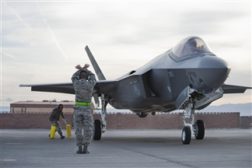
Israel’s Air Force has added new planes, such as the American F-35. Illustrative image of F-35. Image courtesy of the Department of Defense website. The appearance of U.S. Department of Defense (DoD) visual information does not imply or constitute DoD endorsement.
The military challenges facing Israel from the north have grown, but so have Israel’s capabilities in the air—four times as much according to the Air Force, able to overwhelm their northern foe Hezbollah in a fraction of the time. That’s the assessment from Israel Air Force Commander Major General Amir Eshel, who told a conference on Wednesday that “over the last four or five years we have multiplied our capabilities by a factor of 4. What we could do in 34 days during the second Lebanon War, we can now do in 48 hours.”
Good thing, because the growing strength of Hezbollah—which is believed to have stockpiled tens of thousands of missiles—will put more of Israel at risk than before. But Israel hasn’t been just letting Hezbollah grow. Media reports have indicated multiple attacks on weapons in Syria that had been bound for Hezbollah.
Eshel alluded to that in his comments, “Our activities in this period in between wars, beyond removing the threats over us, have an effect that will be measured only with hindsight,” said Eshel, whose comments at the IDC Herziliya Conference 2017 were published by the Israeli Government Press Office. “What we are currently doing, and the results which are very well known to our enemies, to my mind are postponing a war. Does this mean there won’t be a war? One cannot promise that.”
Just because one cannot predict whether or not a war will occur, does not mean that one cannot have an idea of what to expect in such a conflict. And it won’t be easy, according to Eshel. “In the next war we will be called on to fight while our bases are under fire. We are investing a lot in ensuring that in any future state of conflict we have full air superiority a lot faster than in the past, taking into account the capabilities of our foes in Lebanon.”
Civilians also continue to be a pawn in the hands of terror groups such as Hezbollah, who use their own countrymen as human shields for their military positions. Eshel acknowledged that is an additional risk, but believes there is a way for the civilians to escape safely—by running at the sign of conflict.
“We are doing whatever possible to reduce any collateral damage to civilians in any war, and we aspire towards zero civilian casualties. But I cannot delude myself; in every war there will always be people who are harmed inadvertently,” said Eshel. “I have a recommendation to the people of Lebanon: Hezbollah has chosen to stay and infiltrate some of your homes—if you leave your homes as soon as the conflict erupts you will not be harmed.”
In the end, Israel doesn’t want to fight Hezbollah in a war, but also can’t be idle either. Eshel said that “to act in a way that is effective and determined, while avoiding an escalation into war is a very complicated dilemma.”
Beyond the northern front, Israel faces threats across the region. Eshel noted that arms sales in the last few years in the Middle East hit approximately $200 billion—and most of that was for air combat. Given how the region shifted in 2011, Eshel noted that it’s uncertain if it will not change again—which could open new threats. Israel’s response is to be ready for anything.
“These weapons can potentially harm the State of Israel and partially challenges the air forces ability to secure air superiority in the Middle East,” said Eshel.
“We cannot wake up one morning in ten or twenty years and say ‘we forgot to plan for this’. I am not here to share an apocalyptic vision for a Middle East that collapses tomorrow morning, but we have to be ready for war not only in the Northern Arena but in all arenas.”
(By Joshua Spurlock, www.themideastupdate.com, June 21, 2017)
